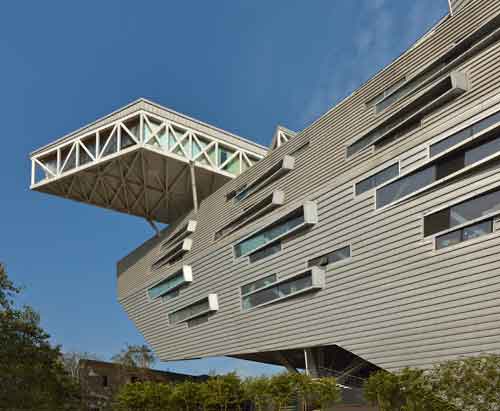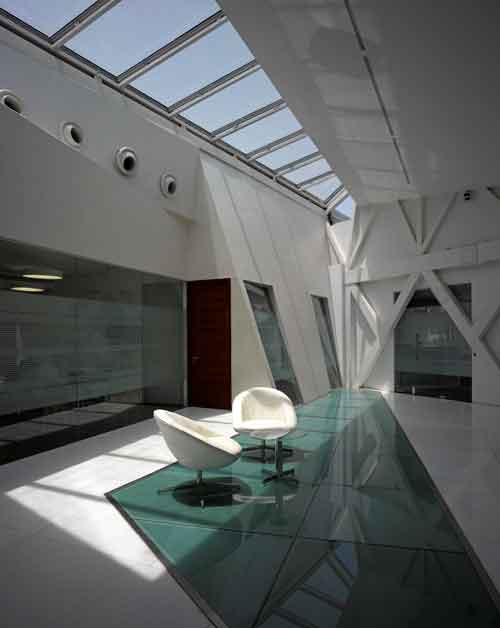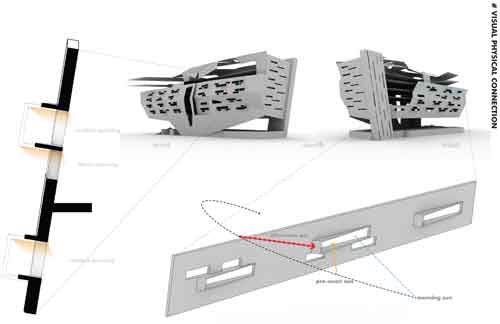
The GMS Grande Palladium project in Mumbai is a critical commentary on some of the antiquated notions that have plagued contemporary commercial design in the subcontinent.
Rapid urbanization and redevelopment has led to a blanket erasure of any identifiable architectural character in Mumbai, barring a few. The site for the GMS Grande Palladium is in close proximity to a newly formed business district in the north of the city, far removed from the historic downtown zone.
It is surrounded by dilapidated structures slated for redevelopment, and, being one of the first sites to be developed, it was the intention of Malik Architecture to try to create, through this building, a framework for the future. The building program consists of commercial space for sale, the client’s office, and some common facilities, such as a cafe, gym, lounge, etc.

The business district near the site had certain planning restrictions, one of which was the mandatory creation of a 3-storey podium meant to optimize street interface. But, it worked exclusively, creating an impermeable barrier between building and street. Malik Architecture inverted this relationship, lifting the building 8.0 meters above the ground, creating an urban porosity and limiting the building footprint, which gave them the freedom to incorporate landscape elements and trees.

Four levels of generic commercial space are bound by a series of faceted, profiled aluminium planes, a subtle nod to the random agglomerations of the Dharavi slums, which is located only minutes away from the site, and whose individual tenements are sheathed in scrap corrugated metal sheets. The steel superstructure has 16.0 meter central spans to allow for flexible planning, and deflected shear skins transmit cantilever loads to the raked members below.
The clients’ fragmented roof office visually disconnects itself from the typical floors, the only tangible link being a segment of the structural skin that turns over to form the wall and roof membranes. The large volumes at the upper levels allude to the industrial spaces of the building’s predecessors.
The uniqueness of this project is that it operates on multiple levels. On the one hand, it uses technology and intelligent design to improve the working environment of its inhabitants, all the while working inclusively in an urban context. On the other hand, it is a critical commentary on some of the antiquated notions that have plagued contemporary commercial design in the subcontinent.

 Name of project:
Name of project: GMS Grande Palladium.
Location: Mumbai, Maharashtra, India.
Client: GMS Group.
Year of completion: 2010.
Architects: Malik Architecture.
Consultants:
-
Structural Engineer – WSP UK
-
MEP Consultant – WSP MEP Delhi
-
Feasibility Study for Green Building Rating – Confederation of Indian Industries – CII Hyderabad
-
Energy Efficiency Studies – Environment Design Solutions – EDS Delhi
-
Landscape Consultant — The Gardeners, Pune
Contractors:
-
Structure and Civil – Pratibha Industries Pvt. Ltd., Mumbai.
-
Glazing – Chiniwalas Pvt. Ltd., Pune
-
Cladding – Vijaynath Interior and Exteriors Pvt. Ltd., Mumbai.
-
HVAC – BlueStar Limited.
-
Plumbing and Fire Fighting – Shree Padmavati Engineers Pvt. Ltd., Mumbai.
-
Electrical – Antelec Ltd., Mumbai
Site Area: 1.25 Acres
Built Area: 1, 80,000 sq. ft.
Photograph Credits: Bharath Ramamrutham.